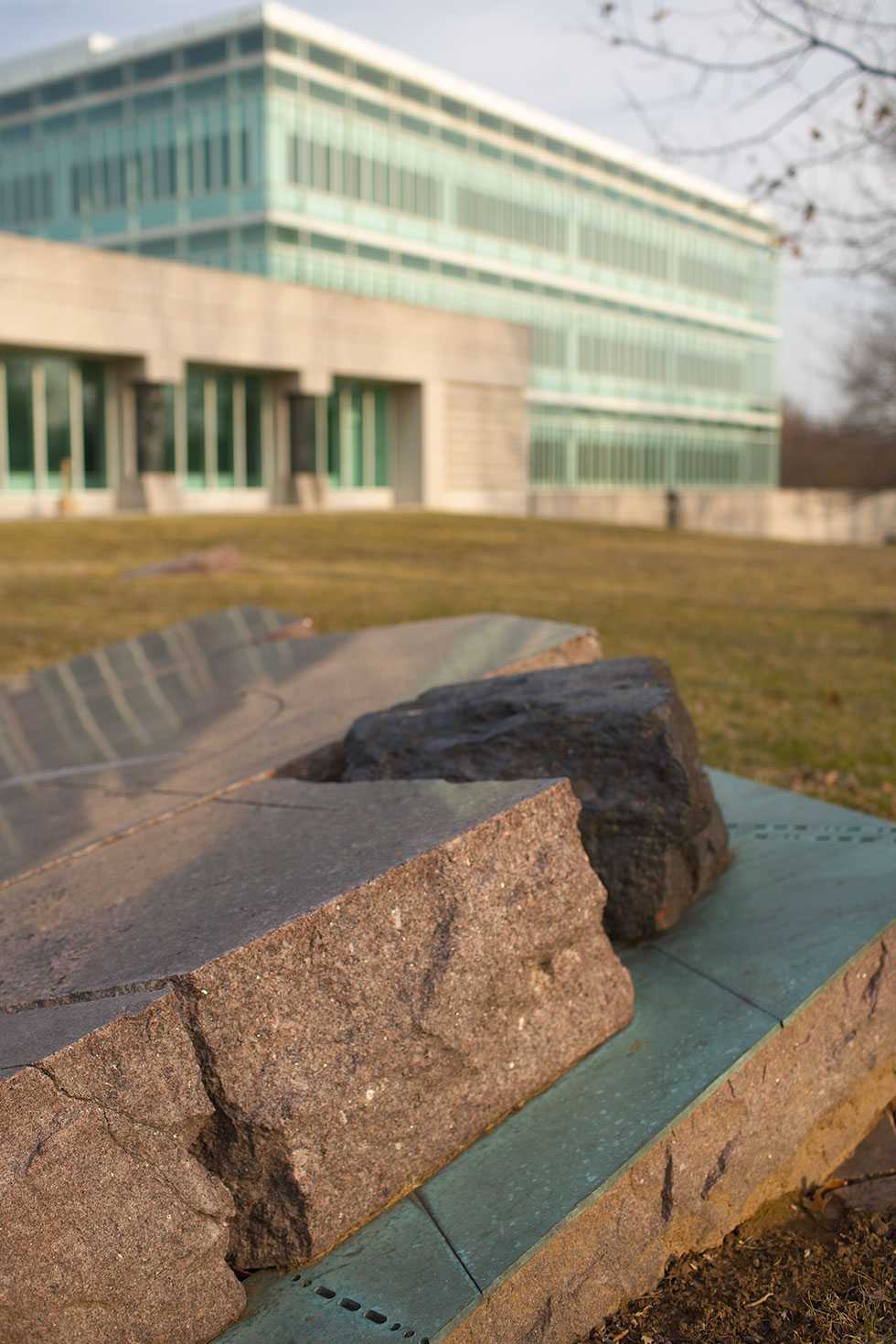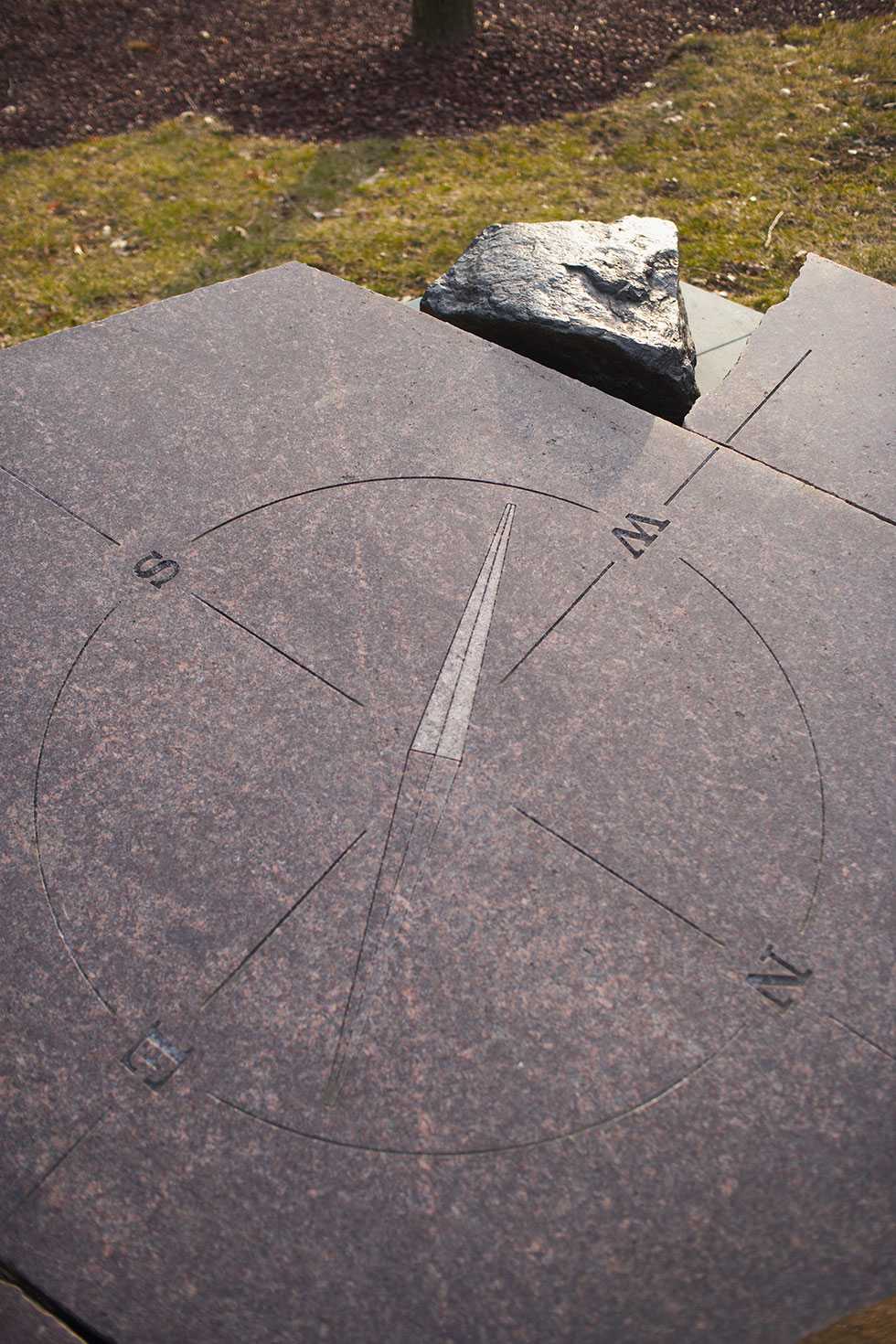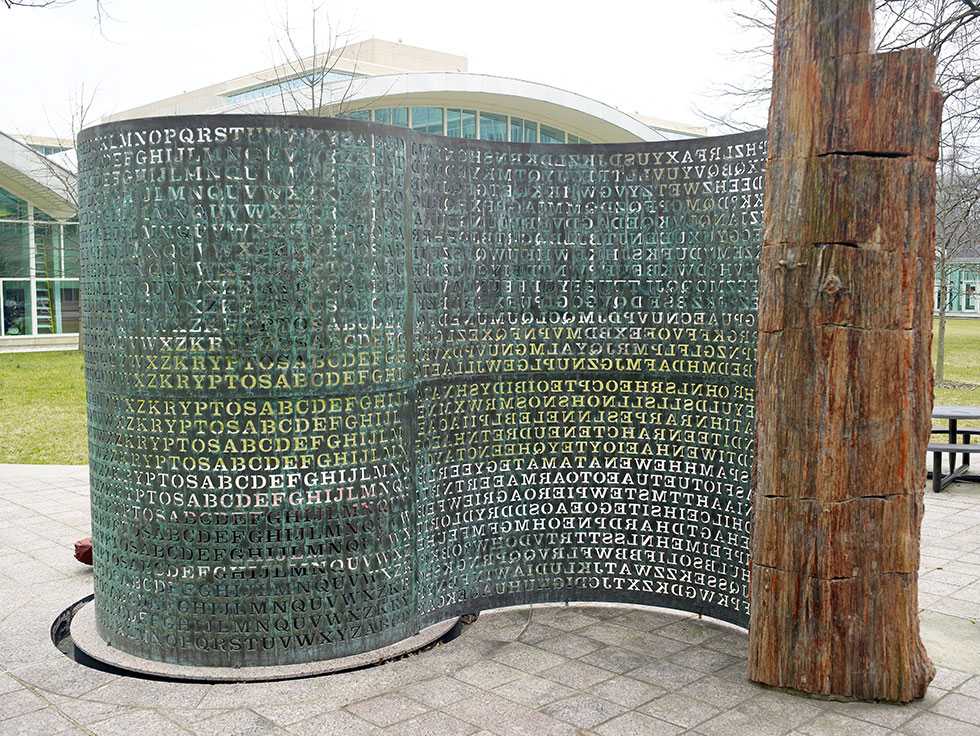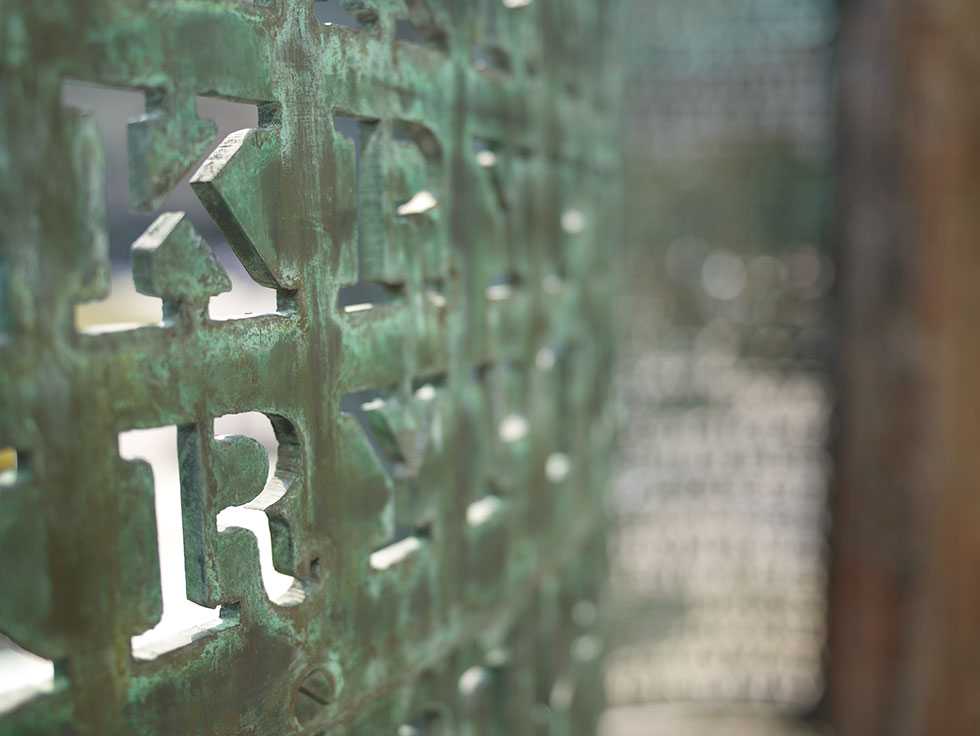About the "Kryptos" Sculpture
James Sanborn’s sculpture “Kryptos” begins at the entrance to the New Headquarters Building and continues in the northwest corner of the New Headquarters Building courtyard.
The theme of this sculpture is “intelligence gathering.” It was dedicated on Nov. 3, 1990. Kryptos incorporates materials native to the United States. A piece of petrified wood supports a large S-shaped copper screen that looks like a piece of paper coming out of a computer printer. On the “paper” are inscribed several enigmatic messages, each written in a different code. The sculpture continues to be a source of pleasure and mystery for Agency employees, with a few taking the challenge to “break the code.”
“Kryptos” © Copyright 1988 James Sanborn. All rights reserved.
Story
Before the New Headquarters Building (NHB) was finished in 1991, thought was given to enhancing the new structure with artwork that was not only pleasing to the eye, but indicative of the Central Intelligence Agency’s work. Under Federal construction guidelines, a small portion of the cost of the new building was set aside to commission original art for the structure.
To achieve the goal of acquiring fitting artwork for NHB, the CIA Fine Arts Commission recommended that the Agency utilize the services of the Art-in-Architecture program of the General Services Administration (GSA). This is a Federal program which has managed the creation of contemporary art for Government buildings for more than 25 years and which has resulted in highly acclaimed works. GSA formed a team composed of experts led by the National Endowment for the Arts and members of the CIA Fine Arts Commission and other Agency employees.
Before starting the task, the Agency side of the joint team developed a Statement of Principles:
"People are the principal resource of the Central Intelligence Agency. It is their intellectual and physical energies that ultimately provide the national policymakers with superior information and analyses---the basis to formulate policies necessary to maintain this country’s position in the world. An esthetically pleasing work environment at its Headquarters is an important stimulus to the efforts of those officers assigned here."
They also listed these key thoughts:
- Art at the CIA should reflect life in all its positive aspects.
- It should engender feelings of well-being, hope.
- It should be forceful in style and manner.
- It should be worldly yet have identifiable American roots in concept, materials, representation, and so forth.
These principles were the guidelines that artists followed as they competed for the $250,000 commission to design artwork for the New Headquarters Building. The combined NEA and CIA panel evaluated each entry and, in November 1988, chose local artist James Sanborn’s conception of "Kryptos" (Greek for "hidden"), a two-part sculpture located at the main entrance to NHB and in the courtyard between NHB and the Original Headquarters Building (OHB) cafeteria.
Mystery
At the entrance to the New Headquarters building, the sculpture begins with two red granite and copperplate constructions which flank the walkway from the parking deck. These stones appear as pages jutting from the earth with copperplate ‘between the pages’ on which there are International Morse code and ancient ciphers. There is also a lodestone (a naturally magnetized rock) co-located with a navigational compass rose.
In the courtyard, a calm, reflective pool of water lies between two layered slabs of granite and tall grasses. Directly across from this is the centerpiece of "Kryptos," a piece of petrified wood supporting an S-shaped copper screen surrounding a bubbling pool of water.
- The petrified tree symbolizes the trees that once stood on the site of the sculpture and that were the source of materials on which written language has been recorded.
- The bubbling pool symbolizes information being disseminated with the destination being unknown.
- The copperplate screen has exactly 1,735 alphabetic letters cut into it.
In addition to its purely aesthetic qualities, Kryptos contains codes that are important to the history of cryptography. When we stand in the CIA courtyard and look at Kryptos from the front, the petrified tree is to the left of the copper screen. From this vantage point the left half of the copper screen is the encoded text and the right half of the copper screen is a series of alphabets, one above the other and is a "chart" called Vigeneries Tableaux developed by 16th century French cryptographer Blaise de Vigenere. In Kryptos this chart has been intentionally flipped so it can only be read from the back of the sculpture. The artist used this "chart" system, in combination with matrix coding systems, to encipher the first three encoded texts on the left side of the screen. The artist designed the fourth section (now referred to as K4) to be very difficult to crack and as of yet, it has not been broken.
The sculpture has been a source of mystery and challenge for Agency employees, other government employees, and interested people outside of government. In early 1998, a CIA physicist announced to the Agency that he had cracked the code for three of the four sections. This was followed a year later by a public announcement from a California computer scientist that he had done the same. As varied as the codes in the sculpture are, so were the methods to crack them. The Agency employee used pencil and paper, and the computer scientist used his computer. No one has yet to break the code for the remaining 97-character message which utilizes a more difficult cryptographic code.
James Sanborn once said "They will be able to read what I wrote, but what I wrote is a mystery itself." Only time will tell if the final message to this multi-layered puzzle is ever revealed.
Artist
James Sanborn is a Washington, D.C.-born artist with a Bachelor of Arts degree from Randolph-Macon College and a Master of Fine Arts from Pratt Institute. Mr. Sanborn is noted for his work with American stone and related materials that evoke a sense of mystery and the forces of nature.
To give shape to "Kryptos," Sanborn chose polished red granite, quartz, copperplate, lodestone, and petrified wood. After reading extensively on the subject of intelligence and cryptography, Mr. Sanborn decided to interpret the subject in terms of how information is accrued throughout the ages. In the case of the two-part sculpture, information is symbolized in the chemical and physical effects that produced the materials and in other more literal ways.
To produce the code for "Kryptos," Mr. Sanborn worked for four months with a retired CIA cryptographer to devise the codes used in the sculpture. Mr. Sanborn wrote the text to be coded in collaboration with a prominent fiction writer.
Contents
Encoded Text
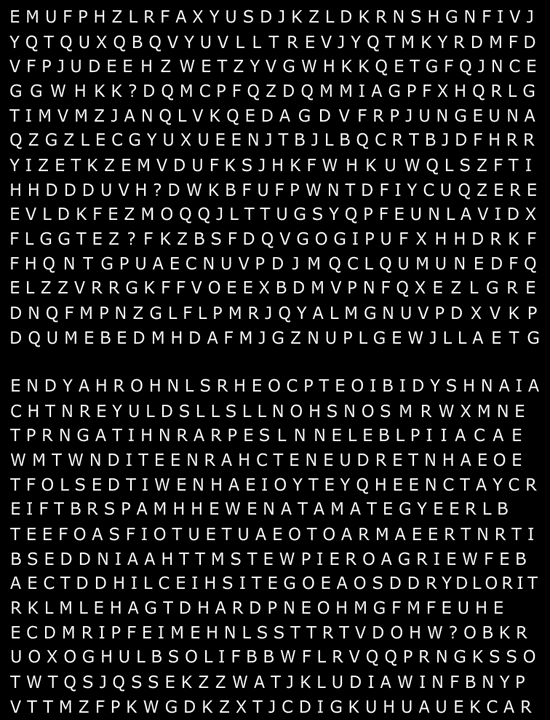
EMUFPHZLRFAXYUSDJKZLDKRNSHGNFIVJ
YQTQUXQBQVYUVLLTREVJYQTMKYRDMFD
VFPJUDEEHZWETZYVGWHKKQETGFQJNCE
GGWHKK?DQMCPFQZDQMMIAGPFXHQRLG
TIMVMZJANQLVKQEDAGDVFRPJUNGEUNA
QZGZLECGYUXUEENJTBJLBQCRTBJDFHRR
YIZETKZEMVDUFKSJHKFWHKUWQLSZFTI
HHDDDUVH?DWKBFUFPWNTDFIYCUQZERE
EVLDKFEZMOQQJLTTUGSYQPFEUNLAVIDX
FLGGTEZ?FKZBSFDQVGOGIPUFXHHDRKF
FHQNTGPUAECNUVPDJMQCLQUMUNEDFQ
ELZZVRRGKFFVOEEXBDMVPNFQXEZLGRE
DNQFMPNZGLFLPMRJQYALMGNUVPDXVKP
DQUMEBEDMHDAFMJGZNUPLGEWJLLAETG
ENDYAHROHNLSRHEOCPTEOIBIDYSHNAIA
CHTNREYULDSLLSLLNOHSNOSMRWXMNE
TPRNGATIHNRARPESLNNELEBLPIIACAE
WMTWNDITEENRAHCTENEUDRETNHAEOE
TFOLSEDTIWENHAEIOYTEYQHEENCTAYCR
EIFTBRSPAMHHEWENATAMATEGYEERLB
TEEFOASFIOTUETUAEOTOARMAEERTNRTI
BSEDDNIAAHTTMSTEWPIEROAGRIEWFEB
AECTDDHILCEIHSITEGOEAOSDDRYDLORIT
RKLMLEHAGTDHARDPNEOHMGFMFEUHE
ECDMRIPFEIMEHNLSSTTRTVDOHW?OBKR
UOXOGHULBSOLIFBBWFLRVQQPRNGKSSO
TWTQSJQSSEKZZWATJKLUDIAWINFBNYP
VTTMZFPKWGDKZXTJCDIGKUHUAUEKCAR
Cipher

ABCDEFGHIJKLMNOPQRSTUVWXYZABCD
AKRYPTOSABCDEFGHIJLMNQUVWXZKRYP
BRYPTOSABCDEFGHIJLMNQUVWXZKRYPT
CYPTOSABCDEFGHIJLMNQUVWXZKRYPTO
DPTOSABCDEFGHIJLMNQUVWXZKRYPTOS
ETOSABCDEFGHIJLMNQUVWXZKRYPTOSA
FOSABCDEFGHIJLMNQUVWXZKRYPTOSAB
GSABCDEFGHIJLMNQUVWXZKRYPTOSABC
HABCDEFGHIJLMNQUVWXZKRYPTOSABCD
IBCDEFGHIJLMNQUVWXZKRYPTOSABCDE
JCDEFGHIJLMNQUVWXZKRYPTOSABCDEF
KDEFGHIJLMNQUVWXZKRYPTOSABCDEFG
LEFGHIJLMNQUVWXZKRYPTOSABCDEFGH
MFGHIJLMNQUVWXZKRYPTOSABCDEFGHI
NGHIJLMNQUVWXZKRYPTOSABCDEFGHIJL
OHIJLMNQUVWXZKRYPTOSABCDEFGHIJL
PIJLMNQUVWXZKRYPTOSABCDEFGHIJLM
QJLMNQUVWXZKRYPTOSABCDEFGHIJLMN
RLMNQUVWXZKRYPTOSABCDEFGHIJLMNQ
SMNQUVWXZKRYPTOSABCDEFGHIJLMNQU
TNQUVWXZKRYPTOSABCDEFGHIJLMNQUV
UQUVWXZKRYPTOSABCDEFGHIJLMNQUVW
VUVWXZKRYPTOSABCDEFGHIJLMNQUVWX
WVWXZKRYPTOSABCDEFGHIJLMNQUVWXZ
XWXZKRYPTOSABCDEFGHIJLMNQUVWXZK
YXZKRYPTOSABCDEFGHIJLMNQUVWXZKR
ZZKRYPTOSABCDEFGHIJLMNQUVWXZKRY
ABCDEFGHIJKLMNOPQRSTUVWXYZABCD
Photos

